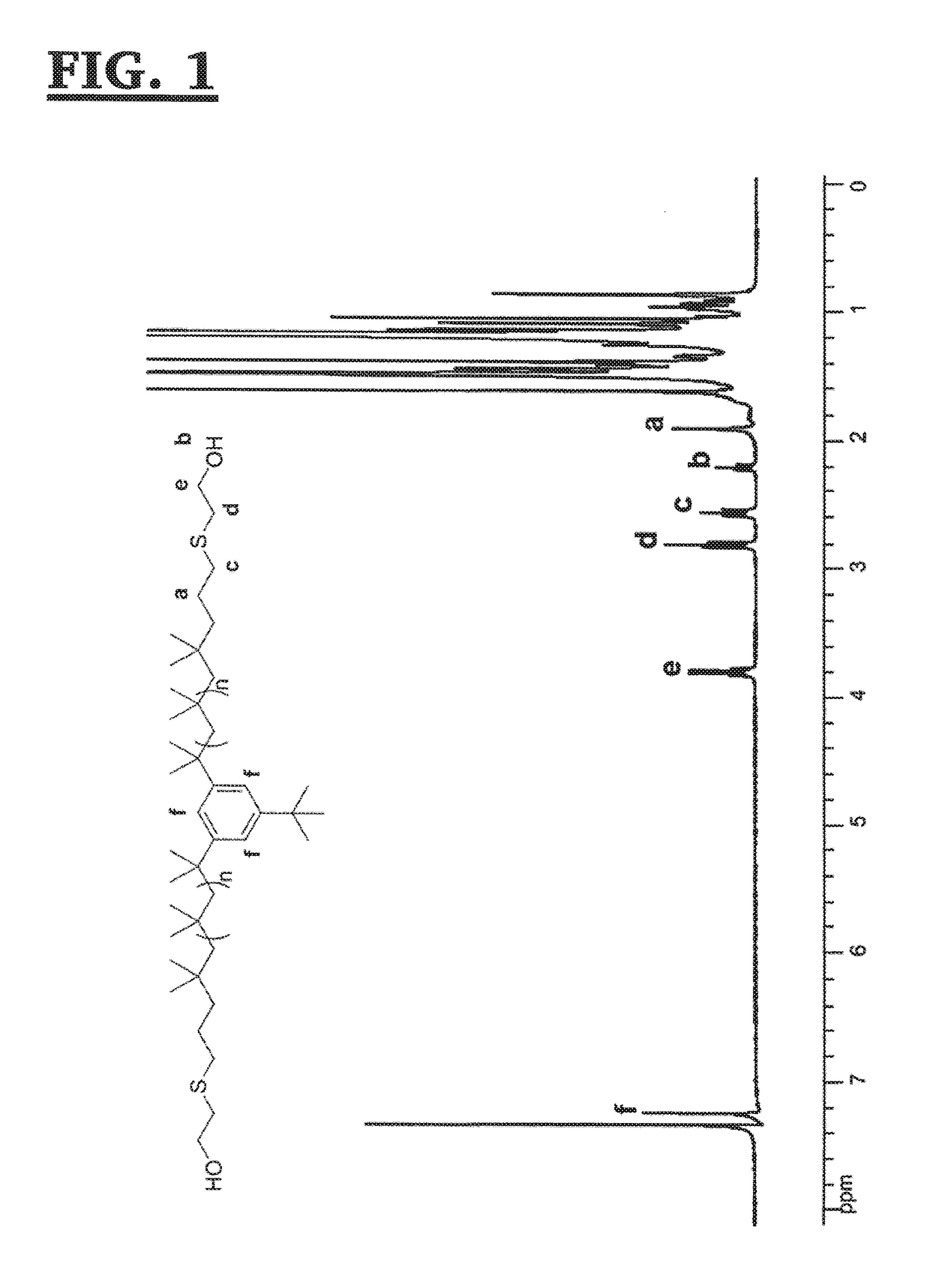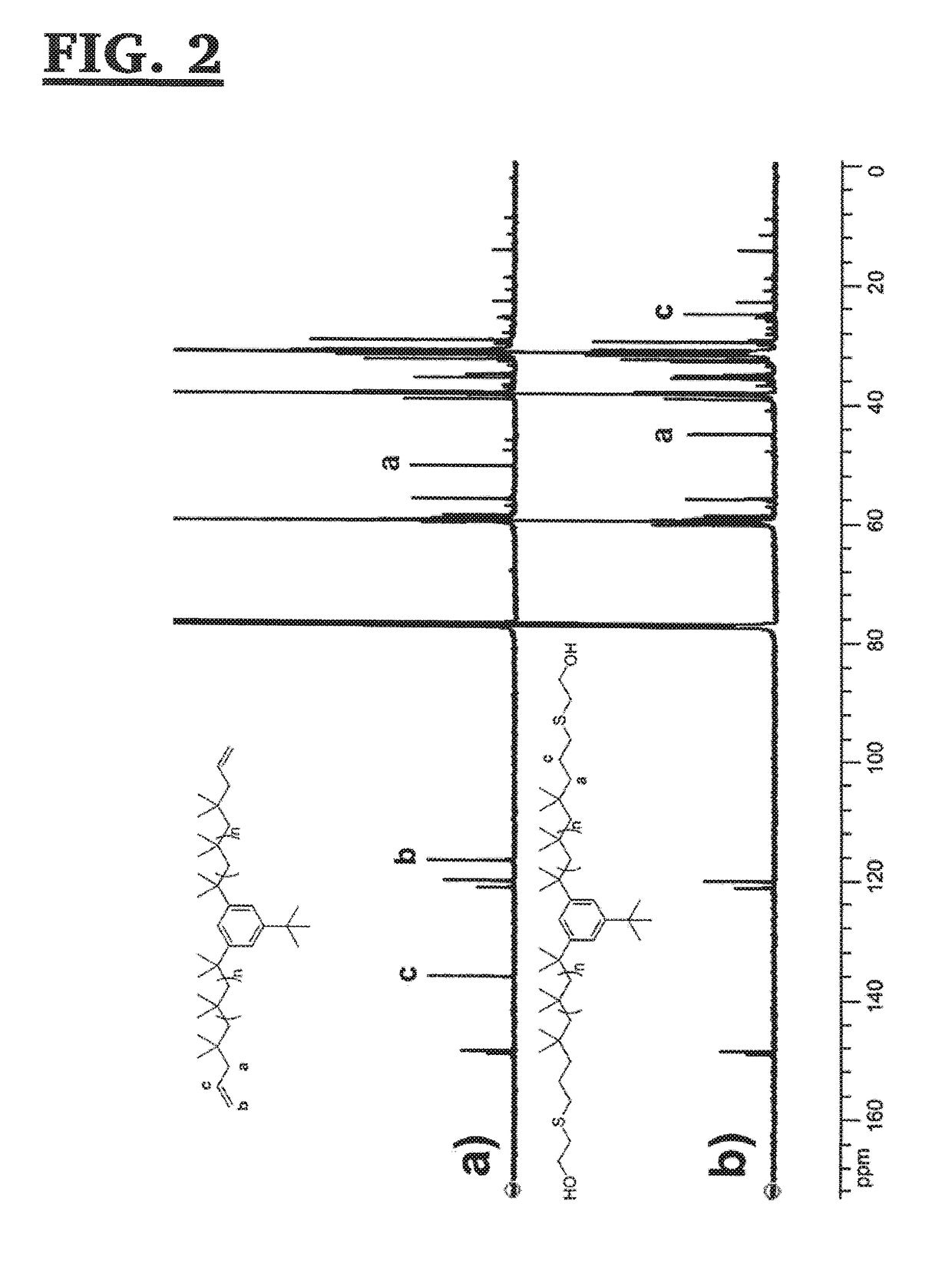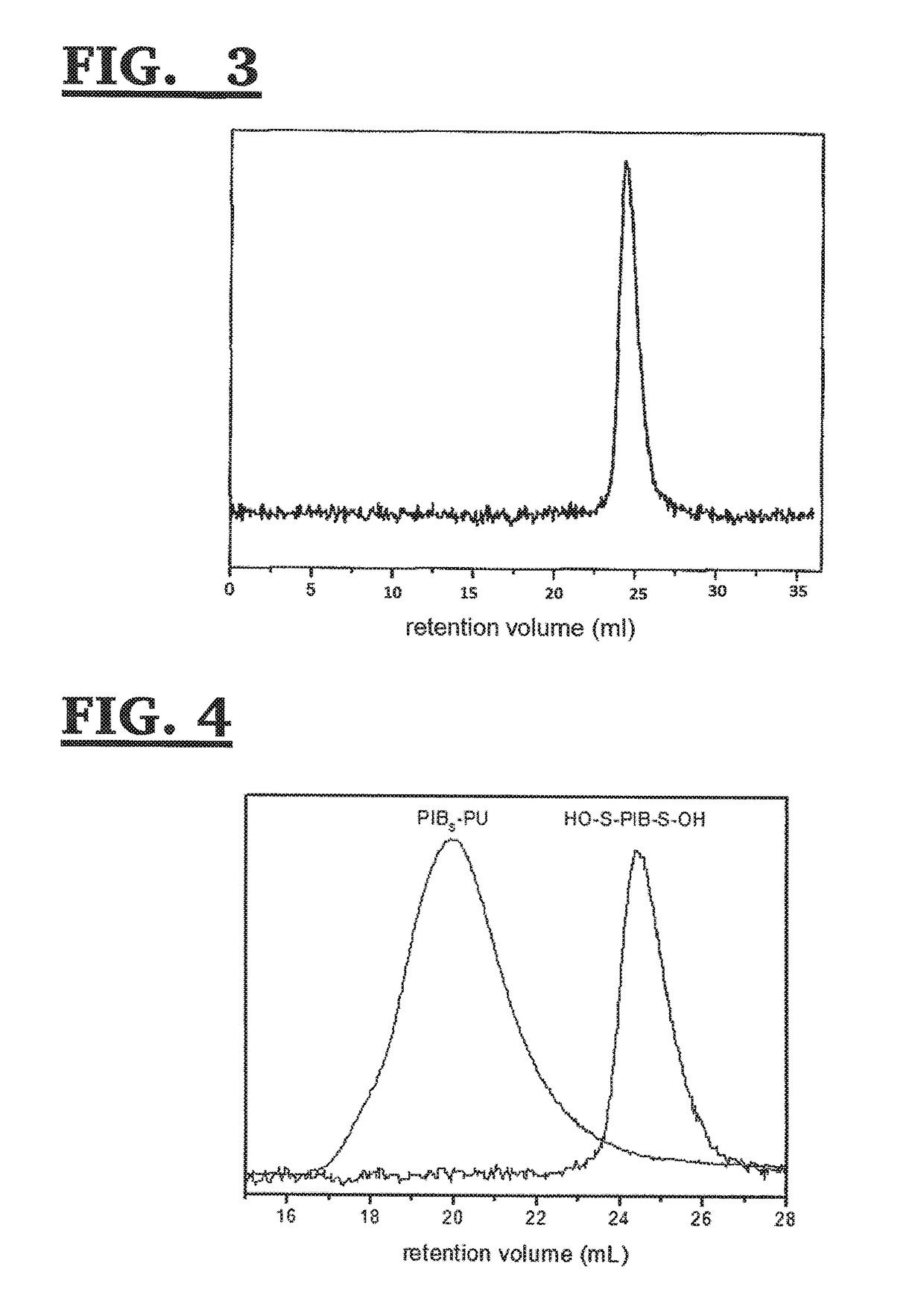Synthesis of -s-ch2ch2-oh telechelic polyisobutylenes and their use for the preparation of biostable polyurethanes
a technology of telechelic polyisobutylene and polyisobutylene, which is applied in the field of synthesis of -s-ch2ch2-oh telechelic polyisobutylene and its use for the preparation of biostable polyurethane, can solve the problems of complex and expensive synthesis of ho-pib-oh, use of relatively expensive, and high cost, and achieves simple and inexpensive methods. , the effect of high yield
- Summary
- Abstract
- Description
- Claims
- Application Information
AI Technical Summary
Benefits of technology
Problems solved by technology
Method used
Image
Examples
example 1
Synthesis of Allyl Telechelc PIB (A-PIB-A)
[0118]Tert-butyl-dicumyl chloride (tBudiCumCl) was recrystallized from hexane under a N2 atmosphere prior to use (According to 1H NMR spectroscopy, this initiator contained ˜0.2% double bonded impurities, and 2Cl2 (310 ml) and hexane (510 ml) were injected into a 2 liter three neck round bottom flask equipped with a magnetic stirrer, thermometer and N2 inlet. Next, the tBudiCumCl (2.136 g, 7.434 mmol) and TMEDA (2.2 ml, 15 mmol) were added to the CH2Cl2 and hexane, and the mixture was cooled to −78° C. with isopropanol / dry ice mixture under a continuous N2 stream. Isobutylene (IB) (26.3 ml, 356 mmol) was then injected into the reaction mixture and TiCl4 (12.9 ml, 118 mmol) was added to start polymerization. After 15 minutes allyltrimethylsilane (11.7 ml, 74 mmol) was added to terminate the reaction, and the system was stirred for 45 minutes. The reaction was then quenched with MeOH (˜200 ml) and NaHCO3 solution (˜200 ml). The organic phase w...
example 2
Preparation of OH—S-PIB-S—OH from A-PIB-A Via Thiol-Ene Click Reaction
[0120]The A-PIB-A of Example 1, above (10.955 g, 3.534 mmol), 2,2-dimethoxy-2-phenylacetophenone (DMPA) (102 mg, 0.398 mmol) and chloroform (non-distilled, 18.8 ml) were placed into a 50 ml round bottom flask and stirred in the dark until all the A-PIB-A dissolved. Then, (i) mercaptoethanol (0.75 ml, 11 mmol) was injected; (ii) the mixture was stirred for a few minutes; and (iii) irradiated with a medium pressure Hg lamp (Fusion UV Inc. F300S) for 15 minutes, while the flask was cooled with an ice-water bath. The solvent was removed under reduced pressure; the crude mixture was then dissolved in hexane, and precipitated three times into methanol. The product was then redissolved in hexane, washed with water, dried over MgSO4, filtered and dried. The product, a colorless oil (10.6 g, yield=92.7%), was characterized by 1H-NMR and 13C-NMR spectroscopy, and gel permeation chromatography.
[0121]The resonances in the 1H-...
example 3
The Synthesis of PUs Containing OH—S-PIB-S—OH (60 wt %), HMDI, BG9 and HDO
[0123]The HO—S-PIB-S—OH of Example 2 (1.2469 g, 0.3730 mmol) and 4,4′-Methylenebis(cydohexyl isocyanate) (HMDI) (0.4860 g, 1.8525 mmol) were placed into a 20 ml glass vial and the system was deoxygenated by evacuating the air with vacuum and replacing it with nitrogen. THF (3 ml) was then injected, the solution was heated to 60° C. Dibutyltin dilaurate (DBTDL) catalyst (11.7 mg, 0.019 mmol-0.22 ml of 50 mg / ml THF solution) was then added, and the solution stirred for 1 hour to obtain the ‘prepolymer’. A solution containing hexamethylene diol (HDO, (0.1099 g, 0.9300 mmol) and poly(tetrahydrofuran) with Mn˜650 g / mol (BG9) (0.2426 g, 0.3732 mmol) dissolved in 2 ml THF was separately prepared and deoxygenated, and then injected into the prepolymer solution (the vial was washed with 1 ml of THF). The system was stirred for 4 h at 60-65° C. Approximately 2 ml of THF was added while the solution was warm, and the sys...
PUM
| Property | Measurement | Unit |
|---|---|---|
| Temperature | aaaaa | aaaaa |
| Temperature | aaaaa | aaaaa |
| Percent by mass | aaaaa | aaaaa |
Abstract
Description
Claims
Application Information
 Login to View More
Login to View More - R&D
- Intellectual Property
- Life Sciences
- Materials
- Tech Scout
- Unparalleled Data Quality
- Higher Quality Content
- 60% Fewer Hallucinations
Browse by: Latest US Patents, China's latest patents, Technical Efficacy Thesaurus, Application Domain, Technology Topic, Popular Technical Reports.
© 2025 PatSnap. All rights reserved.Legal|Privacy policy|Modern Slavery Act Transparency Statement|Sitemap|About US| Contact US: help@patsnap.com



